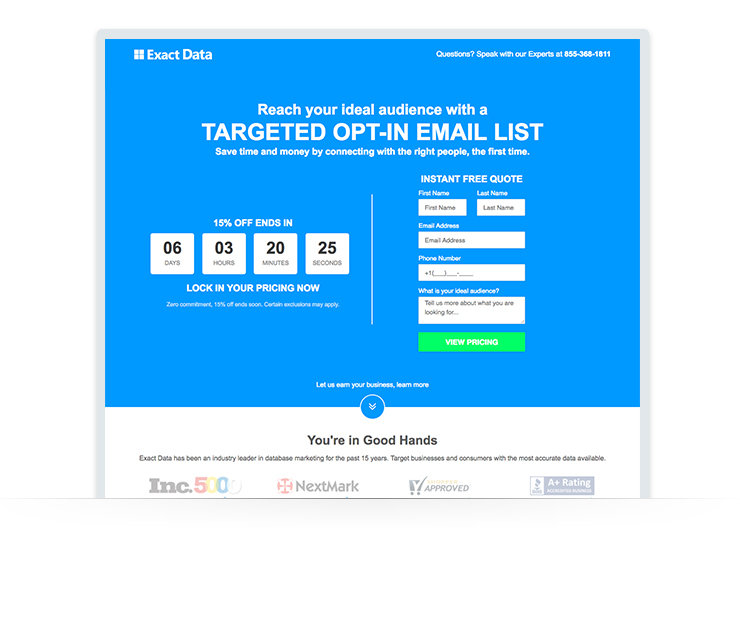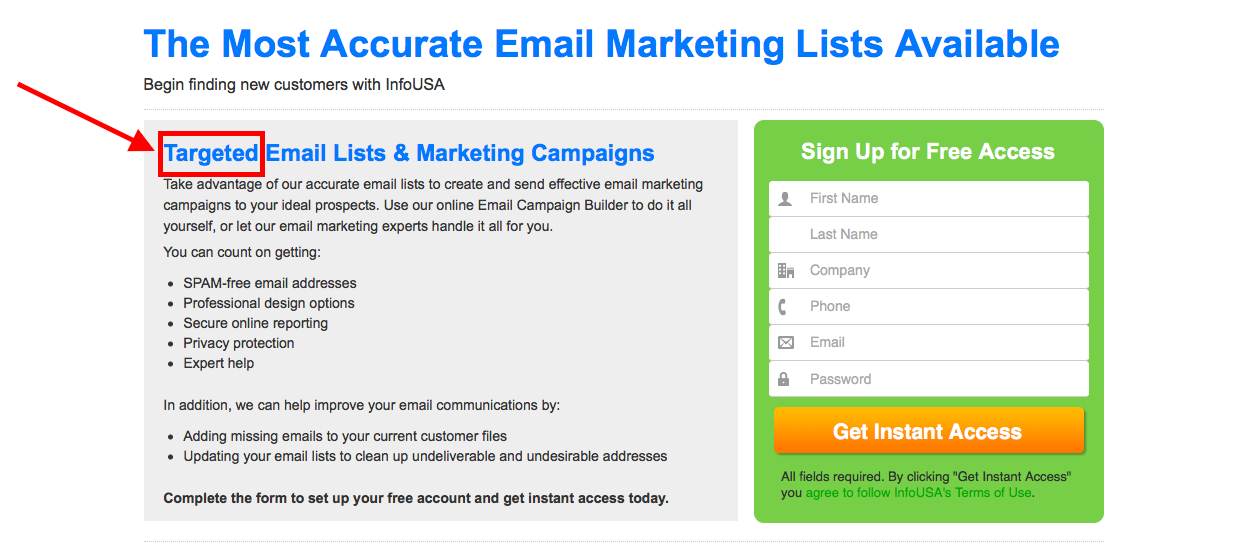The Ugly Truth about Buying Email Lists
By Kelly Forst August 24, 2020
You want peace of mind when sending your messages to your subscribers.
That means making sure that your email is delivered to your subscribers’ inboxes. But it also means knowing you’re sending legally compliant marketing emails.
When you’re just starting a business — or just starting to use email marketing to promote your business — it can be really tempting to buy an email list.
You want to grow your business — and fast. What better way than to start promoting your business to a large audience?
Here’s the ugly truth: cutting corners and buying an email list will hurt you and your business in more ways than one. It’s why AWeber and other reputable email services will not allow you to import a purchased email list.
Read on to learn everything you need to know about buying an email list. And how to grow an email following the right way.
Why AWeber does not allow you to import a purchased list.
Here at AWeber, we have a group of trained specialists on our Best Practices team that monitors your email deliverability 24/7. Our Best Practices team ensures AWeber provides you the highest deliverability rates in the email marketing industry. We help you make it into the inbox, and not the spam folder.
That means our Best Practices team is on the lookout for AWeber customers importing or sending messages to purchased email lists. Purchased lists are directly against AWeber’s Terms of Service and can result in a closure of your account.
And they come with big problems: Sending messages to a purchased email list can cause significant damage to your marketing initiatives, hurt your chances of making it into the inbox, and ruin all of your hard work.
Plus, penalties for sending unsolicited email to a purchased list could range anywhere from hefty fines to even jail time, depending on your country’s anti-spam laws.
Is it legal to buy email lists?
When it comes to email marketing, there are a few laws you need to know that will help you make informed decisions — especially about purchasing email lists.
GDPR — or the General Data Protection Regulation — is a European law that directly states that email subscribers must opt-in to receive your emails with active consent. Even if you’re not based in Europe, if have customers or subscribers in Europe, you must comply with GDPR. And, it must be clear what your subscribers can expect to receive from you.
Buying an email list is a clear violation of GDPR. Want to learn more about GDPR and what it means for your business? Check out Your GDPR + Email Marketing Playbook.
But there are also a few other laws that reinforce why you should never buy an email list.
The CAN-SPAM Act is a United States law that regulates commercial email. While it doesn’t actually prohibit someone from buying and selling email addresses, it does prohibit sending bulk unsolicited emails. And if you’re sending to a purchased email list, that’s exactly what you’re doing. You would be in violation of the law.
Plus, the California Consumer Privacy Act (CCPA), which went into effect on January 1, 2020, protects the personal information of California residents. Businesses need to honor requests from California residents to “access, delete, and opt-out of sharing or selling their information.”
By purchasing an email list, you can’t be sure that a vendor has followed those rules. And, California is only the first state to enact a law like this — others are likely not far behind.
Why you should never buy an email list
Our Best Practices team doesn’t only catch bad actors using purchased lists — even well-intentioned businesses can fall into the trap of buying email lists. After all, a purchased list sounds like a great idea in theory; you feel like you can start marketing your product or service right away to a list of subscribers, instead of having to grow your list from scratch, right?
Wrong. Simply put, buying an email list will hurt you more than it will help you.
Some companies make money by offering new email marketers a “shortcut” to building their email lists. So they compile email address lists and advertise them as:
- “Targeted”
- “Opt-in”
- “Verified”
- “Clean” (a clue that purchasing lists is inherently dirty)
- “Real Time”
Here are some examples:
When buying a list of email addresses, you don’t have proof of who else may have also purchased those addresses, what list those subscribers signed up for originally, or the date those subscribers signed up. While the company selling the list may say it’s “Opt-In” or “Verified,” you have no idea what content they first signed up for.
When you send messages to a purchased email list, you don’t have explicit opt-in to be emailing those subscribers. Explicit opt-in — meaning subscribers actively and knowingly gave you permission to email them (i.e. filling out a sign up form on your website) — is required for a quality list, says AWeber’s Best Practices Manager, Josh Smith. “If you don’t have explicit opt-in, you are bound to have problems,” he explains.
And fair warning: Confirmation does not equal permission.
The confirmation message is one of the first emails you send to subscribers when they are added to your mailing list. In it, a subscriber can click on a link to confirm that they requested information from you.
However, you can’t just send a confirmation message to a purchased list — because they never gave you permission to email them in the first place. They never requested to be on your email list. Confirmation can only be used as a second step in order to build a more engaged list.
So how do email addresses end up on purchased email lists?
Any email address can end up in a purchased email list database.
Vendors that sell email lists scrape email addresses off old lists, get attendee lists from conferences, and pick them off websites that have nothing to do with your specific business.
This means the people you’re emailing may not be interested in what you do at all.
For instance, your purchased list may claim to have opted-in for your gardening tips. In reality, however, those email addresses signed up for sports news and updates.
The result: The subscribers on your purchased list have no interest in your gardening content. They never open your messages, or, worse, they mark your messages as spam.
Even if the vendor collected the email addresses legitimately, none of the subscribers on the purchased list are aware of you or your business. They don’t expect to hear from you, and are more likely to mark you as spam.
How buying email lists will hurt you and your business
Most subscribers know if they have requested specific information from you or not. Sending unsolicited information to subscribers who did not request it can be damaging to your business and your deliverability.
Internet Service Providers (ISPs) — like Gmail, Hotmail, or Yahoo! — track if a subscriber opens an email, clicks a link, or reports a message as spam in their inbox.
If the engagement is good — meaning, a subscriber constantly opens your messages, forwards them, or clicks the links inside — this tells the ISP to route future emails straight to the inbox.
Related: Not sure if your email open or click-through rates are good? Check out AWeber’s 2020 Email Marketing Statistics Report to discover average email engagement.
However, if a subscriber is unengaged, then an ISP will route your emails to the spam folder. And if a large portion of your subscribers are unengaged — which will most likely be the case with a purchased list — it can hurt your sending reputation. All of your messages may end up in the spam folder whether a subscriber wants to read your emails or not.
What to do instead of buying an email list
There are other great ways to grow your list that don’t involve buying email addresses.
Build a strong brand
Successful businesses are built on strong brands that people love. And strong brands are built on exceptional products that solve a problem for your unique audience.
That’s the winning formula. Offer a valuable product or service, build and deliver it with care, and look for every opportunity to delight your customers.
Buying an email list skips too many crucial steps in building a strong brand. With a purchased list, unprepared recipients aren’t likely to think, “Oh gosh, I was just hoping for yet another offer from a company I don’t know! Let me click over to their site and buy something!”
If you were hoping to sell to this list, you might want to adjust your expectations.
Convincing someone to opt in to receiving emails from you means earning their trust, and the only way to do that is by solving their problems, providing value, and treating them with respect. That takes time and hustle.
Create a sign up form for your website.
Collect email addresses from people who visit your website. Make sure your sign up form is accessible and visible across the site to make it easy for people to find and subscribe.
You’ll see higher engagement and better results since your subscribers signed up for the content themselves.
Create a landing page to drive subscribers to.
Don’t have a website? No problem. A landing page is a fantastic way to promote your business and encourage sign ups.
While navigation is limited on a landing page, that’s a good thing for email sign ups. Write your landing page in a way that explains the value of signing up for your email list clearly and highlights your sign up form on the page.
Offer a lead magnet to entice people to sign up for your list.
A lead magnet is a freebie or incentive that encourages people to sign up for your email list. In exchange for their email address, you give them something valuable that solves a problem for them.
For instance, if you’re a vegan health coach, a guide like ‘My top 5 vegan recipes for weight loss,” could be a valuable offer to your audience. If they want the guide, they’ll gladly hand over their email address and will be eager to hear from you.
You can get incredibly creative with your lead magnets. Offer calendars, guides, checklists, recipes, the list is endless as long it’s valuable and solves a problem for your audience. Get 22 more brilliant lead magnet ideas.
Turn your social media following into email subscribers.
Add your sign up form to your Facebook page and publish the AWeber hosted URL to your sign up form or landing page as a pinned Tweet. Or, include a link to sign up for your newsletter or email list in your Instagram bio.
Ask your personal relationships to sign up for your email list.
There’s no better way to spread the word about your business and email newsletter than through your personal relationships.
Let friends and family know about your venture. Make it easy for them to forward your email and ask them to help spread the word.
Want to learn more about how to get more subscribers and grow your business without buying an email list?
Get all the tools and resources you need to become an email pro with our guide, “How to Grow Your Business with Email Marketing.”
 87% off ends soon!
87% off ends soon! 


